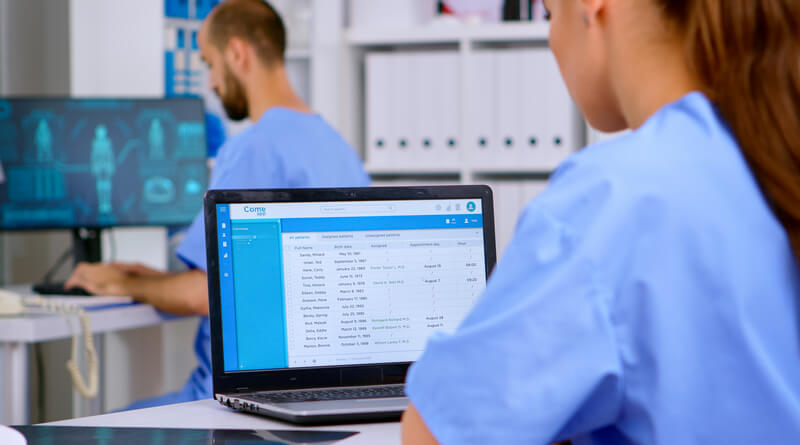Blockchain: Opportunities for Healthcare

How is that exciting if the data is recorded as a distributed database? Yes, with the assistance of Blockchain you can do this task quickly. This distributed database is known to be a block. The Cryptography technique joins these blocks together to store the recording in digital format. A famous currency Bitcoin is managed according to this block-chain technique. Because it protects the transaction terms.

Yes, it is impossible to cheat, hack, and change the recorded data once information is added to it, but there are different ways to structure the data. Each “block” has a massive amount of information. Specific storage is kept for an individual block. When the storage capacity is filled then that block is closed. At that moment the locked block connects to the previously sealed one. Through this process, the network chain is formed as a blockchain. When new information is added, new blocks are formed and included in the chain.
Scope
Blockchain technology is being used to solve problems in many fields, including healthcare.
It protects the patient’s data and general involvement in the patient’s health. Also can decrease costs. Blockchain provides the benefit to transfer the patient’s records from one hospital to chemist’s organizations, surgeons, and other laboratories for problem-solving.
It plays an important role in the medical field by saving the life of any patient by identifying the serious disease. So, Blockchain technology is considered one of the best for protecting, medical data sharing, and enactment in the field of healthcare.
It increases the rate of awareness in the analysis of medical issues. Mainly, this technology reduces the patient’s fear of coping with their medical data as it provides the highest level of security system.
For accessing the data, the system offers interconnection, verification, adaptability, and answerability. Patient issues like sugar level and blood pressure data can also be determined and stored by attaching some useful devices and also with the help of things on the internet.
It is very helpful for the doctor whose patients require these values at a normal level. The exchange of health information gives more security and enhances the healthcare quality consists of some main steps.
- Information about the health of the patient.
- Monitoring systems and things on the internet provide the ability to collect more data.
- Increases the advocating through electronics.
- Messages are kept with complete security.
- It claims full medical assurance.
Benefits
- For protecting the data, blockchain encodes all the data.
- It uses the highest level of security to guard each sort of data.
- Virtual and real-world value can be held because of its digital system.
- The term transparency gives the benefit to get ownership of any company.
- Blockchain is a much cheaper, faster, and better option for the care of patients.
- This system updates from time to time for sharing the data between the provider and patient.
- Smart deals always maintain the balance in the data.
- Most efficient system.
- It decreases the mistakes and scams that occur in clinical trials.
- Organizations and researchers get the inclusive spectrum of data without any interruptions.
- This technique explores the disease timely which helps to eradicate the origin of the disease.
- Blockchain also shields information about DNA (genomic data).
- In blockchain networks, electronic medical records (EMRs) guard the data and send it to other medical centers with full safety.
Applications
Effects analyzer of the specific process: Patient’s recorded secure data provides the opportunity to analyze the effects of specific problems or diseases. After identifying, it is easy to accomplish the disease. Blockchain provides the capability of storing data and making the results faster. You can straightforwardly collect significant data in case of surgery or any other crisis.
Clarity and welfare: Some patients’ diseases take a long time with the doctors. This system gives security and honesty for a long time. In case of any erratic ailment, it also offers the tracks for clinical terms and support in cure. Transparency allows exchanging of medical data between some physicians and medical laboratories to recognize the issue speedily without anxiety.
Antiseptic evaluation: Blockchain technology is used to check the results of clinical experimentations. It explores whether the desired result is matched with the analysis result or not. This useful system can also allow suggestions for reasonable medicines by monitoring the chain.
Decreases the extra and needless expenses: Blockchain gives the biggest opportunity to complete the whole treatment from verification of problems to cure with nice time management. This benefit saves the patient’s life, time, and also money. Many problems of clinical treatment like report completion, interoperability, failure, and theft of data all are resolved by time management property.
Information about origin: For any problem solution, finding out the origin of the problem is the main and essential step to eradicating the issues. That’s why blockchain is considered the most valuable and most used mobile app. It gives the display key points about any medical issue of high quality. This would increase the better medication options. Clinical trials, medicinal products, vaccines, and medications are all factors that become well in their sector by this wonderful system.
Keeping records about health: In the world of medicine, keeping health records is pleasantly done in blockchain coordination. Assurance supervision, allocation of records for healthcare, keeping the healthcare data by electronics, and performing the task for management are all applications in the medical field by the system of the blockchain.
Conclusion
Blockchain is the system in which we can store information by making the blocks. These blocks are interconnected with each other. No one can hack, change or copy the recorded data. This process is used worldwide in fields. The healthcare sector is one of the important parts. Blockchain saves the patient’s data with full protection. You can exchange data with other medical laboratories to diagnose without any fear of missing, copying, or changing the saved data. After studying the above benefits and opportunities, you can understand how important blockchain technology is in the healthcare center. For any curing of the disease must select blockchain technology to save life and money.




















